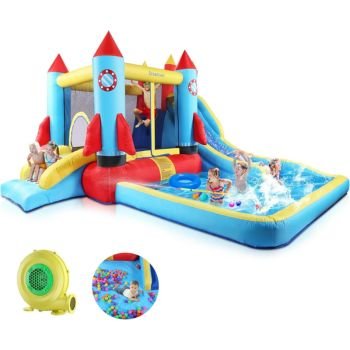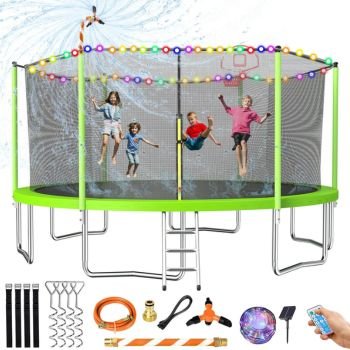Introduction to Swing Sets
When it comes to creating the ultimate backyard play space, swing sets are often the first thing that comes to mind. Whether you grew up soaring through the air on a squeaky old swing or climbing on monkey bars until your arms burned, swing sets have always been a symbol of outdoor fun. Today, parents face an important decision: should you go for a DIY swing set or buy a ready-made, store-bought one? This decision isn’t as simple as it sounds, and that’s exactly what we’re going to explore.
Swing sets aren’t just about fun—they’re about building memories, encouraging physical activity, and giving kids a safe place to let out their energy. The right swing set can become the centerpiece of your backyard, transforming it into a mini playground. But before you run to the store or grab your toolbox, it’s important to weigh the pros and cons of DIY swing sets vs. store-bought swing sets.
Why Swing Sets Are Popular Among Families
Swing sets have been a family favorite for decades, and for good reason. They provide endless entertainment without the need for screens, gadgets, or trips to the park. Kids crave the freedom of running outside, climbing, sliding, and swinging, while parents love the idea of keeping them active and away from technology.
Another major reason is convenience. Having a swing set right in the backyard saves parents from constantly driving to playgrounds. It also offers a safe, controlled environment where kids can play under watchful eyes. For many families, swing sets also become social hubs—friends and neighbors’ children gather, birthdays are celebrated outdoors, and the backyard transforms into a lively hangout spot.
From a practical standpoint, swing sets add value to a home as well. Future buyers often see them as a family-friendly bonus. This makes the decision of choosing between a DIY swing set vs. store-bought even more critical.
The Importance of Outdoor Play for Kids
We live in an age where children are more drawn to tablets and video games than fresh air and sunshine. That’s why swing sets are more than just “toys”—they’re a tool for healthier development. Outdoor play builds strength, coordination, and balance. Swinging alone is excellent for core muscles, while climbing challenges problem-solving skills.
Beyond physical benefits, outdoor play supports mental health. The thrill of swinging high or conquering a climbing wall gives kids a sense of accomplishment and confidence. Plus, playing outdoors reduces stress and improves social skills when kids play together.
This is why the debate of DIY swing set vs. store-bought matters. The right choice ensures your child gets all these benefits without compromising on safety or fun.
Understanding DIY Swing Sets
Before you run to your local hardware store, it’s essential to understand what goes into a DIY swing set. A DIY swing set isn’t just about saving money—it’s about customization, creativity, and control. It allows families to build a playground that fits their space, budget, and unique vision.
What Is a DIY Swing Set?
A DIY swing set is exactly what it sounds like—a playground structure built by you (or with a little help from handy friends and family). Unlike store-bought swing sets that arrive with instructions and pre-cut parts, DIY sets can range from completely handmade builds to semi-prepared kits where you do most of the assembling.
DIY swing sets are especially appealing to families who want something unique. Want a pirate-ship-themed fort? Or maybe a two-story playhouse with swings attached? With a DIY project, the possibilities are endless.
However, DIY doesn’t necessarily mean “cheap.” While you can save money compared to some store-bought options, costs can add up if you opt for premium materials or complex designs. Still, the biggest benefit lies in customization and the satisfaction of building something with your own hands.
Types of Materials Commonly Used in DIY Swing Sets
When planning a DIY swing set, the materials you choose will determine the look, safety, and longevity of the structure. Each material comes with its advantages and drawbacks, and choosing the right one is critical in deciding whether DIY is worth the effort compared to store-bought alternatives.
Wooden Swing Sets
Wood is the most popular choice for DIY swing sets. It’s versatile, sturdy, and has that classic playground look. Cedar and redwood are particularly popular because they resist rot and insects, making them long-lasting.
The main perk of wood is customization—you can cut, shape, and stain it however you want. Plus, wood is aesthetically pleasing and blends naturally with a backyard environment.
The downside? Wood requires maintenance. It needs sealing and inspections to prevent splinters, cracks, or decay. Without regular upkeep, a wooden swing set won’t last nearly as long as a premium store-bought one.
Metal–Swing Sets
Metal is another common option for DIY builds, particularly for families seeking durability without the upkeep wood requires. Metal swing sets are typically made from steel or aluminum, which makes them resistant to rot, pests, and weather damage.
They are often cheaper and quicker to assemble but don’t offer as much room for customization as wood. A major drawback is that metal can get very hot in the sun, making it uncomfortable or even unsafe for kids during peak summer.
Hybrid Options
Some families opt for hybrid swing sets that combine wood and metal. For example, a wooden frame might be paired with metal swings and chains for durability. This approach balances customization with strength, offering the best of both worlds.
The decision ultimately comes down to preference, budget, and how much time you’re willing to invest in upkeep.
✅ Related Articles
- Metal vs Wooden Swing Sets: Which is Better for Kids?
- Best Outdoor Playhouses for Backyards: 10 Fun & Safe Picks
- 10 Best Heavy-Duty Swing Sets for Older Kids | Tested
- 2026’s Best Swing Sets for Kids | Top 10 Picks Parents Love
Exploring Store-Bought Swing Sets
Now let’s talk about the other side of the debate: store-bought swing sets. These are the ones you’ll find at major retailers, specialty playground companies, or even big-box hardware stores. They range from affordable metal sets to elaborate wooden fort-style playsets that look like mini castles.
What Defines a Store-Bought Swing Set?
A store-bought swing set is a pre-designed, mass-produced play structure that comes in a box (or multiple boxes) with all the parts, tools, and instructions needed for assembly. In most cases, you’re still doing some level of DIY by putting it together, but you don’t need to design or source individual materials.
For families who don’t want to deal with measurements, woodcutting, or complicated blueprints, store-bought sets are appealing. They offer convenience and peace of mind because they are usually tested for safety standards before hitting the shelves.
Common Features and Designs of Store-Bought Options
Store-bought swing sets vary widely in size, design, and quality. Here are the most common types:
Pre-Assembled Sets
These are the simplest type—basic swings and slides that require minimal assembly. They’re perfect for younger kids or smaller yards, and they usually cost less than complex structures. However, they can be outgrown quickly.
Modular Swing Sets
Modular sets give you more flexibility. You can add slides, climbing walls, monkey bars, and towers over time. This type appeals to families who want a customizable playground without the full responsibility of building from scratch.
Branded Premium Swing Sets
Big-name brands offer high-end swing sets made with top-quality materials like cedar or powder-coated steel. These often include playhouses, bridges, rope ladders, and multiple slides. They come at a premium price but provide long-lasting durability and a polished look.
When comparing a DIY swing set vs. store-bought, this category often stands out because it guarantees safety and longevity while still offering a “wow” factor in the backyard.
Pros of DIY Swing Sets

Building your own swing set can be incredibly rewarding. Beyond the practical benefits, it’s about the joy of creating something with your own two hands. Let’s break down the major advantages.
Customization and Personalization
One of the biggest draws of DIY swing sets is freedom. You’re not stuck with a cookie-cutter design—you can create something unique that matches your vision. Want extra-high swings? A double-decker playhouse? A climbing wall that looks like a castle turret? You can build it.
DIY also allows you to adapt to your backyard’s specific size and layout. Unlike store-bought sets that come in fixed dimensions, DIY sets can be designed to fit around trees, slopes, or limited space.
Cost-Effective Option for Families
While not always cheaper, DIY sets can be significantly more budget-friendly if you already have tools and access to affordable materials. For example, sourcing second-hand wood or repurposing materials can dramatically cut costs.
Store-bought sets often charge a premium for branding and convenience, so if you’re willing to put in the work, you can save a good amount of money.
A Fun Family Project
For many families, building a swing set together becomes a bonding experience. Kids can get involved in simple tasks like painting or choosing colors, while adults handle the heavy lifting. It’s a chance to teach children about tools, teamwork, and responsibility while creating something they’ll enjoy for years.
This aspect makes DIY sets more than just playgrounds—they’re family memories in the making.
Cons of DIY Swing Sets
Of course, DIY isn’t all sunshine and rainbows. There are some serious drawbacks you’ll want to consider before committing.
Safety Concerns and Construction Quality
Safety is the number one concern with DIY swing sets. If measurements are off, bolts aren’t secure, or materials aren’t strong enough, the set could collapse or cause injuries. Unlike store-bought sets that undergo safety testing, DIY sets rely entirely on your skills and knowledge.
Even the most careful builder can miss small details, and when kids are involved, those details matter.
Time and Effort Required
Building a swing set from scratch isn’t a weekend project—it can take several weeks depending on the complexity. Between planning, measuring, cutting, assembling, and safety-checking, you’ll invest a lot of time. For busy parents, this can be overwhelming.
On top of that, mistakes can add delays and costs. If you miscut wood or underestimate how much material you need, you may end up spending more than if you had bought a ready-made set.
Durability Issues Compared to Store-Bought
While you can build a strong DIY swing set, the truth is that store-bought models are often designed with industrial precision and high-grade materials. Unless you invest heavily in premium supplies, your DIY set may not last as long or handle as much weight as a commercial one.
For families who want something that lasts through multiple children over many years, store-bought may be the more practical option.
Pros of Store-Bought Swing Sets

If you’re not the “grab a hammer and start building” type, store-bought swing sets can be a lifesaver. They’re designed to be straightforward, durable, and ready for family fun without the stress of construction from scratch. Let’s look at the biggest advantages.
Convenience and Time-Saving
The most obvious benefit of a store-bought swing set is convenience. Instead of weeks of planning, measuring, and cutting, you get a kit that comes with everything you need. Most sets include pre-drilled holes, step-by-step instructions, and all the hardware required. For many busy parents, this alone makes store-bought sets worth every penny.
Some companies even offer professional assembly services, so you don’t have to lift a finger. Imagine ordering a swing set online, and within a few hours of delivery, your kids are already climbing and swinging. That’s the beauty of convenience.
Tested for Safety
Safety is a huge plus for store-bought swing sets. Unlike DIY versions, which rely on your skills and guesswork, commercial sets are safety-tested to meet industry standards. This means they’re built with weight limits, safe angles, durable materials, and child-friendly finishes.
Parents get peace of mind knowing the structure won’t collapse or cause harm because it was engineered and tested for safety before being sold. This is particularly important for families with younger kids or multiple children who will put the set through heavy use.
Durability and Warranty Options
High-quality store-bought swing sets are built to last. Manufacturers often use pressure-treated wood, powder-coated steel, or weather-resistant plastics designed to withstand years of outdoor conditions. Many also come with warranties—something DIY swing sets simply don’t offer.
This means if a slide cracks or a swing chain breaks within the warranty period, the company will replace it. That kind of security isn’t available when you build on your own.
Cons of Store-Bought Swing Sets
While store-bought swing sets bring a lot to the table, they’re not perfect. Before you click “buy now,” it’s important to weigh the drawbacks.
Higher Cost Compared to DIY
One of the biggest downsides is price. A simple metal swing set may be affordable, but once you move into wooden or modular playgrounds, the cost can easily run into thousands of dollars. Add professional installation, and you’re looking at a significant investment.
In contrast, if you’re handy and resourceful, a DIY swing set can be built for a fraction of the cost—especially if you source discounted or reclaimed materials.
Limited Customization
Store-bought sets are designed for mass production, which means customization is limited. You can choose from available models, but you can’t design something completely unique like you can with a DIY build.
For example, if your yard has a slope, a tree in the middle, or an unusual layout, fitting a pre-made swing set might be tricky. With DIY, you can adapt the design to your space.
Assembly Challenges
While store-bought sets save time compared to DIY, they still require assembly. And let’s be honest—those instruction manuals aren’t always easy to follow. Many parents report that it takes multiple adults, specialized tools, and several weekends to put everything together.
If you don’t want the hassle, hiring professional assembly adds another cost on top of an already expensive purchase.
DIY Swing Set vs Store-Bought: Cost Comparison
At the heart of the decision for many families is budget. Let’s break down the costs to help you understand where each option stands.
DIY Swing Set Costs
- Materials: $200 – $800 (depending on wood/metal quality)
- Tools: $50 – $300 (if you don’t already own drills, saws, etc.)
- Hardware: $50 – $150 (bolts, screws, brackets)
- Extras: $50 – $200 (paint, sealant, slides, chains)
👉 Total: Anywhere from $400 – $1,500
If you already have tools and access to discounted materials, DIY can be extremely cost-effective. However, mistakes or upgrades can push costs higher.
Store-Bought Swing Set Costs
- Basic Metal Sets: $150 – $500
- Mid-Range Wooden Sets: $600 – $2,000
- Premium Modular Sets: $2,000 – $5,000+
- Professional Assembly: $200 – $800 (optional)
👉 Total: Anywhere from $200 – $5,800+
While entry-level store-bought sets can be cheaper than DIY, more advanced models with slides, towers, and climbing walls often cost significantly more.
👉 You Might Be Interested In
- Best Outdoor Climbing Toys for Kids Under 5
- 10 Must-Have Playsets for Kids | Perfect for Small Backyards & Limited Spaces
- 10 Best Budget Swing Sets Under $500 That Parents Love
- Best Toddler Playsets in 2026 | Durable, Safe & Affordable Options
- Best Indoor Playsets for Kids in 2026 | Safe, Affordable
- 10 Best Toddler Swing Sets for Indoor & Outdoor Fun
DIY Swing Set vs Store-Bought: Safety Considerations
When kids are involved, safety is non-negotiable. Both DIY and store-bought swing sets come with risks, but the factors differ.
DIY Swing Set Safety Risks
- Improper installation: If bolts aren’t secured or wood isn’t cut evenly, the structure could collapse.
- Low-quality materials: Using untreated or weak wood may lead to cracks or splinters.
- Lack of testing: Unlike commercial sets, DIY versions don’t go through safety certifications.
To improve safety, DIY builders should invest in high-quality hardware, inspect regularly for wear and tear, and use child-safe finishes.
Store-Bought Swing Set Safety Benefits
- Industry standards: Most sets comply with ASTM or CPSC safety guidelines.
- Weight limits: Tested for maximum loads, ensuring durability.
- Smooth finishes: Parts are designed to avoid sharp edges or splinters.
The main risk comes during assembly—if you don’t follow the manual correctly, the swing set could still be unsafe. That’s why professional installation is often recommended.
DIY Swing Set vs Store-Bought: Longevity and Maintenance
Durability is another key factor. A swing set is an investment, and you’ll want it to last through years of climbing, swinging, and sliding.
DIY Swing Set Durability
Longevity depends heavily on materials and construction skills. Cedar and redwood can last 10–15 years with proper maintenance, while untreated pine may only last 5–7 years. Regular sealing, tightening bolts, and checking for wear is essential.
Store-Bought Swing Set Durability
Premium store-bought sets often come with weather-resistant finishes and reinforced designs, giving them an edge in durability. Many last 15–20 years with minimal upkeep, especially when warranties cover replacement parts.
The downside is that cheaper store-bought sets (especially metal ones) may rust, bend, or crack within a few years, making DIY with quality materials a better long-term choice.
DIY Swing Set vs Store-Bought: Space and Size Considerations
One of the most overlooked factors when choosing between a DIY swing set vs. store-bought is space. Your backyard’s size, layout, and terrain will play a huge role in determining which option is best.
DIY Swing Set Flexibility with Space
DIY builds give you maximum freedom to design according to your backyard’s shape and size. Have a narrow space? You can build a long, slim design with swings in a line. Have a wide, open yard? You can spread out the swings, slide, and climbing frame to create a mini playground.
DIY is also great for uneven terrain. You can make adjustments on the spot—such as reinforcing one side of the structure or incorporating natural features like trees into the design.
The ability to custom-fit a swing set to your yard makes DIY a great option if your backyard isn’t a perfect square.
Store-Bought Swing Set Size Options
Store-bought sets come in pre-determined sizes, so flexibility is limited. You’ll need to measure your backyard carefully before buying to ensure the set fits safely with enough clearance around swings and slides.
On the plus side, manufacturers often provide clear dimensions and space requirements, so you know exactly what you’re getting. This makes planning easier, even if you have less room to customize.
The drawback is that if your yard has unusual dimensions or slopes, you might have difficulty finding a store-bought set that fits without wasting space.
Which Option Is Better for Families with Young Kids?
If you’re buying a swing set for toddlers or young children, your priorities may be different compared to families with older kids.
DIY for Young Kids
DIY can be a good option if you want to start small. You can build a low-height swing set with fewer risks and gradually expand it as your kids grow. Adding toddler swings, small slides, or even a shaded playhouse can make a DIY set safe and fun for little ones.
The downside is that young kids may quickly outgrow a simple DIY set, meaning you’ll need to rebuild or expand sooner.
Store-Bought for Young Kids
Store-bought sets often come with toddler-friendly options like bucket swings, smaller slides, and safety rails. These sets are also rigorously tested for age-appropriate safety. Parents can feel confident that their toddlers aren’t exposed to unnecessary risks.
As children grow, modular store-bought sets can often be upgraded with taller slides, climbing walls, and more advanced features. This makes them a convenient long-term investment for families with young kids.
Which Option Is Better for Families with Older Kids?
For families with kids aged 6 and up, durability, size, and fun features become the main priorities.
DIY for Older Kids
DIY swing sets for older kids can be a challenge because they need to withstand heavier weights and more intense play. On the plus side, you can build larger structures—like higher swings, climbing walls, or rope ladders—that meet your child’s growing needs.
DIY also allows you to add unique features that aren’t common in store-bought models, such as zip lines, treehouse-style forts, or obstacle courses.
However, safety is a bigger concern here. A poorly built DIY set may not hold up to the rough play older kids demand.
Store-Bought for Older Kids
Premium store-bought sets are often designed for years of use, with reinforced structures that support higher weight limits. They also come with advanced features like rock walls, rope bridges, and tunnel slides that older kids love.
The major drawback is price—larger, heavy-duty sets can be extremely expensive. But if you want a low-maintenance, long-lasting solution, store-bought may be the better choice for older children.
Environmental Impact: DIY Swing Set vs Store-Bought
With more families thinking about sustainability, it’s worth comparing the environmental impact of DIY vs. store-bought swing sets.
DIY and Sustainability
DIY swing sets can be eco-friendly if you choose the right materials. For example, using reclaimed wood or recycled metal reduces waste and gives old materials new life. You also have control over using non-toxic paints and sealants.
However, if you buy untreated, low-quality lumber, your swing set may deteriorate quickly, leading to waste.
Store-Bought and Sustainability
Store-bought sets, especially those made from treated wood or plastic, often involve more industrial processes. Some companies use eco-friendly practices, but not all. The environmental footprint depends on the brand.
That said, because premium store-bought sets last longer, they may actually be less wasteful over time compared to poorly built DIY sets that need replacing every few years.
Final Verdict: DIY Swing Set vs Store-Bought
So, which option should you choose—DIY swing set or store-bought? The answer depends on your priorities.
- If you love customization, saving money, and hands-on projects, DIY might be your best bet. It’s also ideal if you want something tailored to your backyard.
- If you value safety, convenience, and long-term durability, store-bought sets are a better choice, especially for younger kids or families who don’t have the time to build.
Ultimately, both options can provide years of joy and create unforgettable childhood memories. The right choice comes down to balancing budget, time, and how much effort you want to put into the project.
Conclusion
A swing set is more than just a backyard feature—it’s an investment in your child’s health, happiness, and memories. Whether you decide on a DIY swing set vs. store-bought, the most important thing is that it brings your family together outdoors.
If you’re handy, resourceful, and eager for a project, DIY may be the perfect route. If you want peace of mind, convenience, and professional safety standards, store-bought sets are worth the investment.
Either way, you’ll be creating a backyard adventure that your kids will cherish for years.
FAQs
1. Which is cheaper, a DIY swing set or a store-bought one?
DIY swing sets are usually cheaper if you already have tools and access to affordable materials. Store-bought sets can cost more, especially premium models, but they save time and often last longer.
2. Are DIY swing sets safe for kids?
They can be safe if built properly with high-quality materials and regular maintenance. However, they don’t undergo industry safety testing like store-bought sets.
3. How long does it take to build a DIY swing set?
Depending on complexity, it can take anywhere from a weekend to several weeks. Store-bought sets, by comparison, typically take a few hours to a couple of days to assemble.
4. Which lasts longer, DIY or store-bought swing sets?
Premium store-bought sets usually last longer because they’re engineered for durability. DIY sets can also last a long time if built with strong materials and properly maintained.
5. What’s the best choice for small backyards?
A DIY swing set gives you more flexibility to design around limited space. However, compact store-bought sets are also available for smaller yards.









